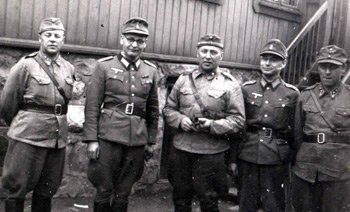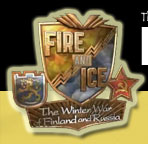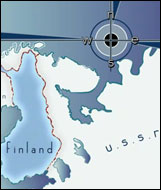


Finnish and German officers in happier times before the Lapland
War
Marshall Kregel
The Lapland War was waged from September 1944 to April 1945 and
was a war the Finns were forced into fighting by the separate peace
terms made with the Soviet Union. One of the demands from Stalin
was if the Germans did not leave by Finnish request by September
15 that the Finn force out all German troops inside of Finnish
borders. The demand for the Germans to leave Finland was made by
Finnish Foreign Minister Carl Enckell on September 2 to the German
ambassador in Helsinki. All parties involved knew that this deadline
was impossible so it was clear that warfare between the Finns and
Germans was almost a certainty.
The Germans were in part prepared for the fighting as they had been concerned as early as the Spring-Summer of 1943 there was a possibility Finland would agree to a separate peace with the USSR. The Germans had improved and added on the road systems in Lapland in case they needed an escape route to Norwegian border. For their part the Finns began to evacuate civilians from the Lapland area on September 7. Interestingly this operation was largely a success due to German assistance in the effort or at least the German units not counteracting these evacuations with hostile fire. While formal relations between the two armies were officially over, it was clear that neither side was looking forward to the fighting. Both armies respected each other and their past common sacrifices against a shared enemy.
The Germans began to regroup into northern Lapland and secured their positions around Petsamo. The 20th Mountain Army was worried that Soviet and Finnish troops would attack their southern flanks, which would mean the Germans would have been trapped and destroyed. The Finns began to move northward but not in an aggressive manner. The Finns seemed satisfied that the Germans would withdraw to Norway as they had earlier been given permission to do by the Finnish command. The German forces to the south of Lapland were small in number and before the September 15 deadline all of these German soldiers had been removed from Finnish soil. The Finnish plan to succeed in driving the Germans from Finland without using force seemed to be going as planned.
This peaceful war attitude would begin to change on the morning of September 15, the deadline for German withdrawn, as German forces launched an attack on the island of Suursaari, which was located in a central position in the Gulf Of Finland. The plans for this attack had been made earlier in the year by the Germans as a plan in case Finland withdrew from the war. It was hoped that by controlling this island the Germans would still be in a position of command in the Finnish Gulf. If the Germans could control the gulf the Red Navy would still be under blockade and would not be able to break free of these restraints.
The attack was launched by surprise as the Finns were assisting in German soldiers' withdraw from the island when German mine-laying ships arrived and demanded the island be surrendered. The Finnish 16th Coastal Artillery Regiment refused and the fighting began. The attack began early in the morning and by the evening it was finished, with the Germans being forced to concede to the Finns after suffering 1,250 either killed or wounded in direct fighting. It was also discovered the Germans had mined large portions of the Gulf Of Finland on the 14th to help in their hopes to keep the Soviet blockade intact.
Even after these hostile actions the Finns did not press their attack against the retreating Germans in the north. The Finns moved four divisions and two brigades northward. In the area of Oulu the 15th Brigade, the Panzer Division, and the 3rd and 11th Divisions moved into position. The Kajaani – Kuhmo was slated to be under the control of the 6th Division and the Frontier Guard Jäger Company. This movement took place during September 13-25 and during this time frame the peace agreement between Finland and the USSR was signed on September 19th. While the Finns seemed to be complying with Soviet demands and were advancing towards war with the German forces, the Germans and the Finns had secretly met in Rovaniemi to time the Finnish advance to coordinate with the German retreats. This would appease the Soviet Union but would not cost Finnish or Germans lives. Even though the Germans were laying mines and destroying bridges, much of this was a ploy to create an appearance of hostile action against the Finns or to protect themselves in case of a Red Army attack.
Mannerheim then ordered the formation of the 3rd Army Corps which was to be a central command army for the Lapland campaign. Lieutenant General Siilasvuo, who had lead the Finns to victory against the Soviets at Suomussalmi in the Winter War, was made the commander of the 3rd Corp and given total control for all operations in Lapland. The new commander arrived in Oulu on September 26th and ceased all negotiations with the German 20th Mountain Army. Fighting between the Finns and the German Army began on the September 27 - 28 with skirmishes involving the Finnish Armored Division and fighting taking place at Pudasjärvi. On September 29 the last Finnish troops left the old border areas and had returned to Finnish soil. On the 30th the Red Army demanded the Finns start operations in full against the Germans or they would consider acting on their own. This was the last thing the Finns wished to take place as they did not want Soviet troops inside their borders creating havoc.
Lieutenant General Siilasvuo quickly began the planning of a landing operation in the area of Tornio. This surprise operation would land Finnish troops behind the German front lines and was seen as the maneuver needed to force a general German retreat from Finland. This attack was quite aggressive and a change from the somewhat calm actions seen earlier in the campaign. The plan seemed to be mainly designed and planned by Siilasvuo himself as later sources report the Finnish high command was not privy to all the plans being launched. There were also those in the Finnish command that felt this attack was too bold and the plan was criticized behind closed doors.
The Finnish attack on the Germans at Tornio began on October 1 with the landing advance by the 3rd Divisions 11th Infantry Regiment. The Finns quickly moved from the port into the city and gained control. By the 2nd Finnish re-enforcements had arrived and were in place. The Germans mounted a counteroffensive to retake the city and the fighting continued until October 8th. Even with air support the Germans were not able to stop the Finnish advance. As a part of this same operation the Finnish 15th Brigade began an advance from Oulu towards the city of Kemi, with Kemi being taken on the 8th. The Finnish soldiers in Tornio had also been moving towards Kemi after being relieved by the 11th Division. Siilasvuo also had the Lagus Armored Division and the 6th Infantry Division move into and take the areas around Rovaniemi. The attacks were lead against the German 7th Mountain Division but the Germans were already beaten and retreating. The Germans were in disarray and the 20th Mountain Army was ordered to move to Norway on October 5 ; however, before the Germans could mobilize this action the Soviets broke through and attacked Petsamo on the 7th. The Germans were beaten and the Soviet gained control of the valuable nickel mines in the region. This also constituted a real threat the Soviets would destroy all the German forces in Lapland.
The Tornio and attacks related to Tornio were a success in many ways; however, these attacks changed the manner in which the Germans waged the war. Until this time the Germans felt they could retreat from Lapland in order but these Finnish and the Soviet attack on Petsamo threatened the existence of all the German forces. As such General Lothar Rendulic began a program of slash and burn warfare in Lapland. His orders resulted in a full one third of all dwellings in Lapland being totally destroyed. The Germans began to burn anything that could be salvaged by the Finns. The Germans were concentrating on an escape path to Muonio but this was countered by a Finnish attack on the Germans in the Rovaniemi area. While the Finns did attack the Germans were able to escape which further angered the Soviets, who still felt the Finns were not doing all they could to route the German forces. Mannerheim was strongly warned that further Soviet action would be required if the Finns did not succeed in their task. The Germans were expelled from Rovaniemi by the 16th, but almost the entire capitol city of Lapland was left in ruins by the Germans.
The Germans were in full retreat and while the Finns and Soviets were in pursuit the Lapland War was for the most part over. The Germans made a stand behind the Schutzwall line in the first few days of November then start to head to Norway. The Finns arrived at Muonio on October 30 but the Germans were already gone. By November 18 the Germans leave the upper tip of Finland into Norway. The Germans only had a handful of soldiers left in Finland and these were first dealt with an attack in January at Lätäseno which forced a German retreat. The last small batches of German soldiers were removed from Finland in late April and the war was over on April 28, 1945. In the Lapland War a little over 1,000 Finnish soldiers were killed while German dead were a bit over 2,000.





